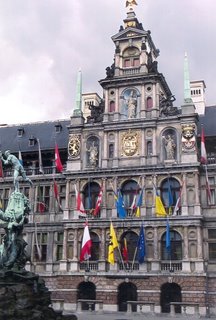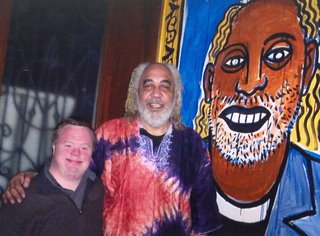 Town Hall, Antwerp, Belgium
Town Hall, Antwerp, Belgium
1. Antwerp's Stories: Brabo. Here is Town Hall, in the main square or Grote Markt. Look at the left - the statue on one foot like a baseball pitcher. That represents Brabo and the Legend of the Hand.
The fellow is a Roman soldier, Brabo, who saved the day. He chopped off the hand of the giant of those times who was exacting a high priced toll from all comers. The soldier chopped off and flung the hand in the river - and the town adopted the hand as its symbol after that. See Brabo statue write-up at www.visitbelgium.com/antwerp.
 Langewapper, Steen Castle, Antwerp, Belgium. Clerically abbreviated. Lange Wapper to be imagined.
Langewapper, Steen Castle, Antwerp, Belgium. Clerically abbreviated. Lange Wapper to be imagined.
2. Now meet the Lange Wapper, or Langewapper, the statue in front of Steen Castle - steen meaning stone. The Steen is all that remains of an old citadel, see www.1911encyclopedia.org/Antwerp,_Belgium. What are those people... oh, for heaven's sake! Gone!
One explanation is that Antwerp's 16th Century Jesuits, see site on Jesuits at www.newadvent.org/cathen/14081a., objected to the attention given to this gentleman's attributes and ordered the lop. Leaving fertility seekers at a loss. Tut. See www.trabel.com/antwerp/antwerp-steen. The statue is so prominent that anyone would ask. FN1
Many other tourist websites give no whiff of this anatomical background of the statue, pointing only to the quality of the shapeshifter, including from giant to small, or trickster as at www.pantheon.org/articles/l/lange_wapper. See more stories at www.belgium.be/eportal/application?languageParameter=en&pageid=contentPage&docId=25539
Others offer both angles: here is a site supporting the endowment element, as well as the demon or shapeshifter: www.holidaycityflash.com/zOut%20of%20the%20Ordinary/strange_statues1.
See stories about Langewapper at FN 2.
..........................................................................................................................
FN 1
Etymology. Wikipedia wants to know the origin of the word "twerp." See en.wikipedia.org/wiki/Twerp.
Perhaps Antwerp's clerical cultural bleeping here, as to the hapless partless Langewapper, triggered the pejorative "twerps" as to the censors. For other brilliant speculations about twerps, see www.thefreedictionary.com/twerp; and more on derivations at www.etymonline.com/index.php?l=t&p=24. Following the thought here, perhaps Antwerp's Exuberance Restoration Committee could hold a referendum to reverse the dismemberment after these 400-500 years. Members only. The Mannequin Pis survives in Brussels, after all. See www.sobi.org/photos/places/Brussels/pis/index. Age discrimination; overzealous culture reframing, leading to dull. See ec.europa.eu/employment_social/publications/2003/cev403001_en.pdf.
FN 2
Here is one of the Langewapper stories: it supports the trickster theory, not the accoutrement. It is in Dutch. See legendesantwerpen.homestead.com/Langewapper. See translation, below, from babelfish.altavista.com/tr.. To get your own translation, copy and past it to any other translation service on the net.
...............................................................................................
This is the fair use translation Babelfish result:
"On a beautiful spring evening were the children still lets play on the stone square, then a visible rich lord came there aanwandelen. He had a large pocket which put full snoep,* all sweet heerlijkheden* which you could consider also but. He distributed them with generous hand to the children, but at the same time walked away he continuously more of the stone square, of keel. He started how longer how more rapidly to run and it was crazy thereby that he distributed more and more snoep. The screaming children continued keep track of him. Eventually were themselves they without them at, already a complete end on the Boomsesteenweg* and suddenly that generous Mr had disappeared, as solved in air. They could hear only spotlach* still its and then knew them that them flies long had followed."
*
aanwendelen: not found yet
snoep: nibble. See www1.worldlingo.com/en/products_services/worldlingo_translator.
heerlijkheden: not found yet
Boomsesteenweg: not found yet
spotlach: not found yet
...................................................................................
Other Langewapper info - do your own translation of this - is it a story or a comment? I have not done this translation. //stadsspelen.blogspot.com/2006/05/stadsspel-antwerpen-in-de-voetsporen.
 Ypres (Ieper) Belgium, relief map, salient, WWI
Ypres (Ieper) Belgium, relief map, salient, WWI Bonaparte Dock, Antwerp, Belgium. Pan Earth All Cuisines Host
Bonaparte Dock, Antwerp, Belgium. Pan Earth All Cuisines Host Antwerp, Belgium. Pan Earth All Cuisines Art and Host
Antwerp, Belgium. Pan Earth All Cuisines Art and Host Docks, Antwerp, Belgium. Pan Earth All Cuisines Restaurant, Diners and Hostess. Bonapartedok.
Docks, Antwerp, Belgium. Pan Earth All Cuisines Restaurant, Diners and Hostess. Bonapartedok. Rubens at Antwerp, Belgium
Rubens at Antwerp, Belgium Butcher's Hall, Medieval. Antwerp, Belgium
Butcher's Hall, Medieval. Antwerp, Belgium Town Hall, Antwerp, Belgium
Town Hall, Antwerp, Belgium Langewapper, Steen Castle, Antwerp, Belgium. Clerically abbreviated. Lange Wapper to be imagined.
Langewapper, Steen Castle, Antwerp, Belgium. Clerically abbreviated. Lange Wapper to be imagined. Escargots cart, Brussels, Belgium
Escargots cart, Brussels, Belgium Michael Jackson stage set, Brusssels, Belgium. Main square. Concert pending.
Michael Jackson stage set, Brusssels, Belgium. Main square. Concert pending.